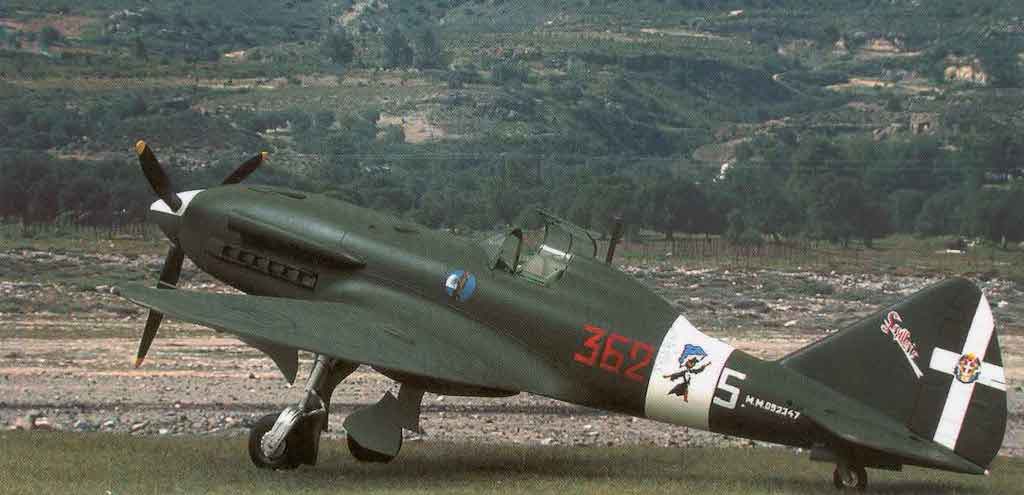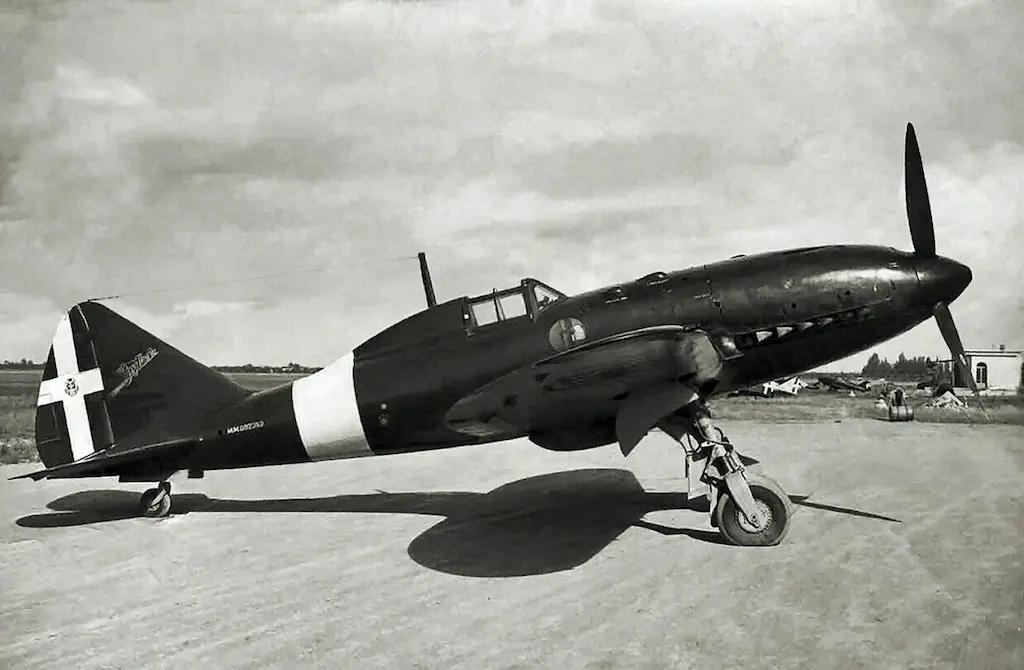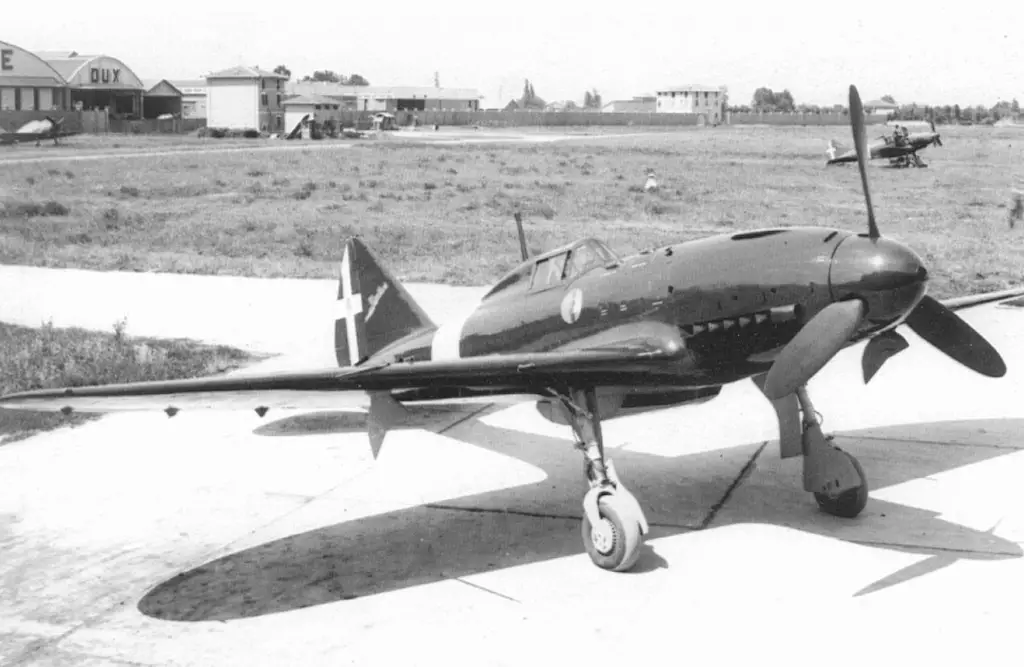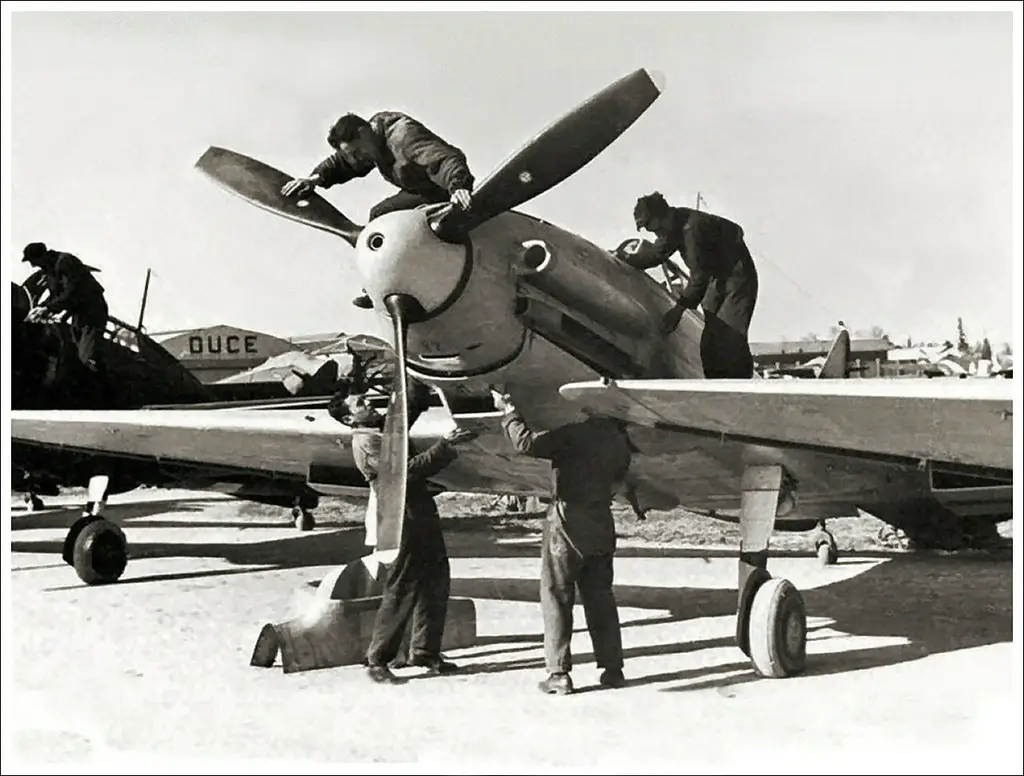Background of the Reggiane Re.2005 ‘Sagittario’
Before discussing the Reggiane Re.2005, we must first take a look at the history of the Regia Aeronautica. Throughout the 1920s and early 1930s, Italy boasted a leading position among the airfaring powers of the world. Products of the Italian military aircraft industry held numerous speed records. The Regia Aeronautica was among the first independent air arms in the world. Theorists such as Giulio Douhet blazed trails in forecasting the future of warfare and the role aircraft were to play in it. While not all their ideas have stood the test of time, they were at the head of their time. Technologically, organizationally, and philosophically, the development of Italian aviation was a thing to envy.

The Reggiane Re.2005 Sagittario MM092347 of the 362 Squadriglia.
However, this lead fell abruptly in the mid-late 30s. The limitations of the Italian industry and leadership led to severe delays in adopting several innovations such as the metal monoplane. In the first years of the Second World War, Italian air forces flew excellent-but-obsolescent or wholly inadequate designs. Against the best of the RAF, they suffered horribly. Only with the advent of excellent fighters such as the Macchi MC. 202 did Italy regain parity with her rivals. However, with ‘Serie 5’ aircraft such as the Reggiane Re.2005, the Regia Aeronautica launched an ambitious bid for aerial supremacy. In March 1943, the Reggiane offering made her furious combat debut, beginning a brief career with the Axis Air Forces.

A 1944 photo of the Reggiane 2005 Sagittario MM092352 in northern Italy.
The Reggiane Series
The earlier Re.2000 and Re.2001 were capable, light multirole designs, and the Reggiane Re.2005 followed this design path. Compared to the predecessors of the line, the most striking difference is the appearance. The fuselage of the fighter was extremely streamlined, helping to enable its high speed and impressive maneuverability. It held onto many key characteristics of the planes that came before it, though, such as the broad and semi-elliptical wings. Compared to the larger Macchi MC.205, the Reggiane frame had a 20% greater wing area. As a result, the Re.2005 enjoyed a marked advantage in high altitude performance.
General Characteristics
The nimble Re.2005 carried a single aviator and occupied small dimensions. It measured only 8.73m front to back, 11m wing to wing, and 3.15m off the ground. On an empty load, the plane weighed 2,600 kg. On a combat load, with ammunition, fuel, oxygen tanks, and other equipment, this increased to 3,610 kg.
The total wing area amounted to 20.4 square meters, and the fighter could climb at a rate of 20m/s to a service ceiling of 11,500m. The maximum wing loading of the Reggiane 2005 totaled 177 kg/m2. The basic operational range reached a distant 980km, but the plane could swap its complement of bombs for up to three drop tanks. With a maximum of 600L additional fuel, operational ranges became as far as 1,270 km. Thanks to characteristics such as the low wing loading and large wing area, it enjoyed a low stall speed of 155 km/h.

The second Reggiane Re.2005 prototype with the DB.605 engine. This image was taken in 1943.
While the Re. 2000 suffered from inadequate power, the final iteration of the line mounted a tremendously powerful engine. The Reggiane Re.2005 carried either the Daimler-Benz 605A-1 or the license-built Fiat Alfa Romeo 1050 RC 58 Tifone inline engines. The German-built engine boasted 1,475 hp, while the Alfa Romeo offering was still-potent at 1,310 hp. providing a top speed of 628 km/h at 6,950 m elevation. The typical cruising speed, though, was 515 km/h.
Early Italian fighters suffered from light armament, but the latest iteration could terrorize any Allied unit on land or air. With two 12.7mm Breda-SAFAT machine guns and three 20mm MG 151 cannon, it could engage Allied fighters and bombers effectively. Additionally, the wing hardpoints could carry a pair of 160 kg bombs. Beneath the fuselage centerline, the plane possessed a hardpoint suitable for an additional 1,000 kg bomb.
Service History of the Reggiane 2005
Where the Reggiane 2005 went, its pilots sung its praises. The first uses of the fighter were with the 22° Gruppo beneath 362a Squadriglia. in the defense of Naples. Italian ace and commander of the 22° Gruppo, Vittorio Minguzzi took the fighter on its first mission on 24 March 1943. On 28 April, they achieved their first confirmed victories.
Minguzzi successfully downed a B-24 bomber, while his group as a whole claimed 14 other bombers damaged. Later on, the unit went to Sicily and opposed British Spitfires during the Allied invasion of the island. There, they demonstrated the ability to fight the finest of the Allied fighter forces on even terms and achieved several kills.
However, the valiant efforts of a few excellent fighters cannot stop the inevitable. Sicily fell, and Italy soon after entered into the Armistice of Cassibile with the Allies. The production lines delivered only 48 units thus far, and some had already been lost.

Ground crew performs maintenance on the Reggiane 2005 Sagittario.
Pilots destroyed an additional six, while the Germans and their Italian puppet state seized all they could. New production ceased, although Reggiane reportedly repaired damaged units. Sources differ on the employment of the remaining fighters, as some claim they fought in the defense of Ploesti. Others, however, claim they opposed Allied bombers over Berlin or that they never left Italy at all.
With such a small production run, the Reggiane Re.2005 did not have a meaningful impact on the war. At wars end, the Italian military retired the design. However, it was still certainly a fantastic design. Along with the Macchi MC. 205 ‘Veltro’, and the Fiat G.55 ‘Centauro’, it demonstrated that the Italian aircraft industry was capable of great things. It can stake a claim to being the finest Axis fighter. It earned the adoration of those who flew it, and the fear of those who flew against it.
Specifications
| Model | Reggiane Re.2005 |
|---|---|
| Crew | 1 |
| Powerplant | (1) Alfa Romeo 1050 RC 58 Tifone, (license built DB 605A-1) 1,310 HP |
| Maximum Speed | 390 mph (628 km/h) at 22,800 ft (6,950 m) |
| Max Ceiling | 37,700 ft (11,500 m) |
| Range | 610 miles (980 km) |
| Length | 28 ft 8 in (8.73 m) |
| Height | 10.4 ft (3.15 m) |
| Wingspan | 36.1 ft (11 m) |
| Armament | Two Breda-SAFAT 12.7 mm machine gun One 20 mm MG 151 cannon (propeller) Two 20 mm MG 151 cannon (wings) |
| Weight | Empty: 5,730 lb (2,600 kg) Max: 7,960 lb (3,610 kg) |